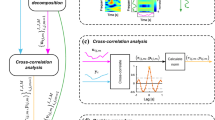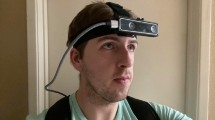Abstract
We used the three-dimensional magnetic search-coil recording technique to study the range of active angular head movements made by squirrel monkeys. There were two goals in this study: (1) to determine the range of angular velocities and accelerations as well as the bandwidth and other frequency characteristics of active head movements and (2) to compare analyses of transients of velocity and acceleration that are studied by residual analysis, Fourier transform, and wavelet transform of the head velocity signal.
The residual analysis showed that the shape and duration of the transients affected the bandwidth. During the time after the head had begun to accelerate, the frequency content of the head movement extended into the range of 6 to 12 Hz. When considering all three planes of rotation, approximately 75% of the transients had peak acceleration between 2,000 and 10,000 deg/s2 and a peak velocity of 50 to 400 deg/s. A peak acceleration of >10,000 deg/s2 was recorded in 10% of the transients.
These findings indicate that active head movements in squirrel monkeys cover a higher range of frequencies, accelerations, and velocities than have typically been used in previous eye-movement and neuronal studies of the reflexes that control gaze. We further conclude that the choice of a method for analyzing transient, time-varying biological signals is dependent on the desired information. Residual analysis provides detailed resolution in the time domain, but estimation of the frequency content of the signal is dependent on the portions selected for analysis and the choice of filters. Fourier transform provides a representation of the power spectrum in the frequency domain but without any inherent temporal resolution. We show that the wavelet transform, a novel method as applied to the signal analysis goals of this study, is the most useful technique for relating time- and frequency-domain information during a continuous signal.
Similar content being viewed by others
References
Aw ST, Haslwanter T, Halmagyi IS, Curthoys RA, Yavor RA, Todd MJ (1996a) Three-dimensional vector analysis of the human vestibulo-ocular reflex in response to high-acceleration head rotations I. Responses in normal subjects. J. Neurophysiol. 76: 4009-4020.
Aw ST, Halmagyi GM, Haslwanter T, Curthoys IS, Yavor RA, Todd MJ (1996b) Three-dimensional vector analysis of the human vestibulo-ocular reflex in response to high acceleration head rotations II. Responses in subjects with unilateral vestibular loss and selective semicircular canal occlusion. J. Neurophysiol. 76: 4021-4030.
Baird RA, Desmadryl G, Fernández C, Goldberg JM (1988) The vestibular nerve of the chinchilla. II. Relation between afferent response properties and peripheral innervation patterns in the semicircular canals. J. Neurophysiol. 60: 182-203.
Belton T, McCrea RA (1999) Contribution of the cerebellar flocculus to gaze control during active head movements. J. Neurophysiol. 81: 3105-3109.
Bizzi E, Kalil RE, Tagliasco V (1971) Eye-head coordination in monkeys: Evidence for centrally patterned organization. Science 173: 452-454.
Daubechies I (1990) The wavelet transform time-frequency localization and signal analysis. IEEE Trans. Inf. Theory 36: 961-1004.
Demer JL (1992) Mechanisms of human vertical visual-vestibular interaction. J. Neurophysiol. 68: 2128-2146.
Durka PJ, Blinowska KJ (1995) Analysis of EEG transients by means of matching pursuit. Ann. Biomed. Eng. 23: 608-611.
Farge M (1992) Wavelet transformations and their applications to turbulence. Ann. Rev. Fluid Mech. 24: 395-457.
Freedman EG, Sparks DL (1997) Activity of cells in the deeper layers of the superior colliculus of the rhesus monkey: Evidence for a gaze displacement command. J. Neurophysiol. 78: 1669-1690.
Goldberg JM, Fernández C (1971) Physiology of peripheral neurons innervating semicircular canals of the squirrel monkey I. Resting Relationship Between Time-and Frequency-Domain Analyses 239 discharge and response to constant angular accelerations. J. Neurophysiol. 34: 635-660.
Gramatikov B, Yi-Chun S, Rix H, Caminal P, Thakor NV (1995) Multiresolution wavelet analysis of the body surface ECG before and after angioplasty. Ann. Biomed. Eng. 23: 553-561.
Grossman GE, Leigh RJ, Abel LA, Lanska DJ, Thurston SE (1988) Frequency and velocity of rotational head perturbations during locomotion. Exp. Brain Res. 70: 470-476.
Guitton D, Volle M (1987) Gaze control in humans: Eye-head coordination during orienting movements to targets within and beyond the oculomotor range. J. Neurophysiol. 58: 427-459.
Halmagyi GM, Curthoys IS, Cremer PD, Henderson CJ, Todd MJ, Staples MJ, D'Cruz DM (1990) The human horizontal vestibulo-ocular reflex in response to high-acceleration stimulation before and after unilateral vestibular neurectomy. Exp. Brain Res. 81: 479-490.
Harris CM (1998) The Fourier analysis of biological transients. J. Neurosci. Methods 83: 15-34.
Harris CM, Wallman J, Scudder CA (1990) Fourier analysis of saccades in monkeys and humans. J. Neurophysiol. 63: 877-886.
Hullar TE, Minor LB (1999) High-frequency dynamics of regularly discharging canal afferents provide a linear signal for angular vestibuloocular reflexes. J. Neurophysiol. 82: 2000-2005.
Jenkins HA (1985) Long-term adaptive changes of the vestibulocular reflex in patients following acoustic neuroma surgery. Laryngoscope 95: 1224-1234.
Kadambe S, Boudreaux-Bartels GF (1991) A comparison of wavelet functions for pitch detection of speech sounds. IEEE catalog number CH2977-7/91, 449-452.
Kaiser G (1994) A Friendly Guide to Wavelets. Birkhauser, Boston.
Kawano K, Inoue Y, Takemura A, Miles FA (1994) Effect of disparity in the peripheral field on short-latency ocular following responses. Vis. Neurosci. 11: 833-837.
Lasker DM, Backous DD, Lysakowski A, Davis GL, Minor LB (1999) Horizontal vestibuloocular reflex evoked by high-acceleration rotations in the squirrel monkey. II. Responses after canal plugging. J. Neurophysiol. 82: 1271-1285.
Lasker DM, Hullar TE, Minor LB (2000) Horizontal vestibuloocular reflex evoked by high-acceleration rotations in the squirrel monkey. III. Responses after labyrinthectomy. J. Neurophysiol. 83: 2482-2496.
Laurutis VP, Robinson DA (1986) The vestibulo-ccular reflex during human saccadic eye movements. J. Physiol. (Lon.) 373: 209-233.
Martins AJ, Kowler E, Palmer C (1985) Smooth pursuit of small amplitude sinusoidal motion. J. Optometric Soc. Am. A 2: 234-242.
Minor LB, Lasker DM, Backous DD, Hullar TE (1999) Horizontal vestibuloocular reflex evoked by high-acceleration rotations in the squirrel monkey. I. Normal responses. J. Neurophysiol. 82: 1254-1270.
Newlands SD, Ling L, Phillips JO, Siebold C, Duckert L, Fuchs AF (1999) Short-and long-term consequences of canal plugging on gaze shifts in the rhesus monkey. I. Effects on gaze stabilization. J. Neurophysiol. 81: 2119-2130.
Nikravesh PE (1983) Computer-Aided Analysis of Mechanical Systems. Prentice-Hall, Englewood Cliffs, NJ.
Paige GD (1983) Vestibuloocular reflex and its interactions with visual following mechanisms in the squirrel monkey. I. Response characteristics in normal animals. J. Neurophysiol. 49: 134-151.
Pozzo T, Levik Y, Berthoz A (1995) Head and trunk movements in the frontal plane during complex dynamic equilibrium tasks in humans. Exp. Brain Res. 106: 327-338.
Robinson DA (1981) The use of control systems analysis in the neurophysiology of eye movements. Ann. Rev. Neurosci. 4: 463-503.
Roy JE, Cullen KE (1998) A neural correlate for vestibulo-ocular reflex suppresion during voluntary eye-head gaze shifts. Nature Neurosci. 1: 404-410.
Senhadji L, Dillenseger JL, Wendling F, Rocha C, Kinie A (1995) Wavelet analysis of EEG for three-dimensional mapping of epileptic events. Ann. Biomed. Eng. 23: 543-552.
Straumann D, Zee DS, Solomon D, Lasker AG, Roberts DC (1995) Transient torsion during and after saccades. Vision Res. 35: 3321-3334.
Thakor NV, Xin-rong G, Yi-Chun S, Hanley DF (1993) Multiresolution wavelet analysis of evoked potentials. IEEE Trans. Biomed. Eng. 40: 1085-1093.
Tomlinson RD, Bahra PS (1986) Combined eye-head gaze shifts in the primate I. Metrics. J. Neurophysiol. 56: 1542-1557.
Tweed D, Sievering D, Misslisch H, Fetter M, Zee D, Koenig E (1994) Rotational kinematics of the human vestibuloocular reflex. I. Gain matrices. J. Neurophysiol. 72: 2467-2479.
van Opstal AJ, van Gisbergen JAM, Eggermont JJ (1985) Reconstruction of neural control signals for saccades based on an inverse method. Vision Res. 25: 789-801.
Westheimer G (1957) Kinematics of the eye. J. Optical Soc. Am. 47: 967-974.
Young RK (1993) Wavelet Theory and Its Applications. Kluwer, Boston.
Author information
Authors and Affiliations
Rights and permissions
About this article
Cite this article
Armand, M., Minor, L.B. Relationship Between Time- and Frequency-Domain Analyses of Angular Head Movements in the Squirrel Monkey. J Comput Neurosci 11, 217–239 (2001). https://doi.org/10.1023/A:1013771014232
Issue Date:
DOI: https://doi.org/10.1023/A:1013771014232




